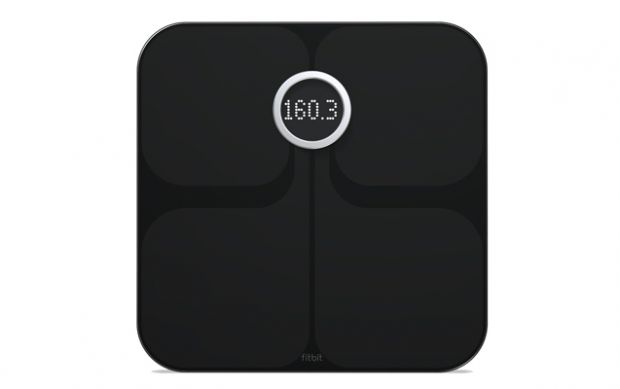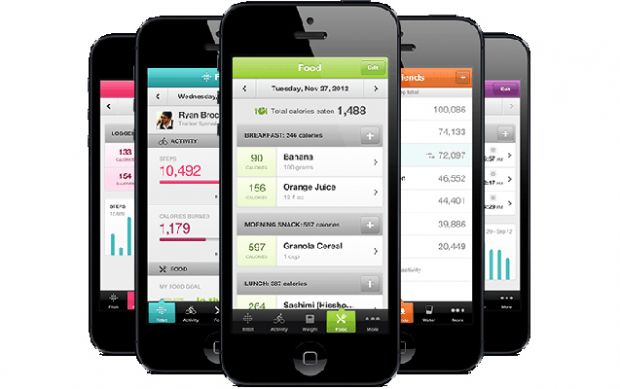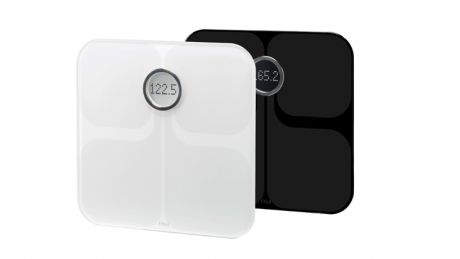You can trust Coach
The Fitbit Aria is a set of internet-connected scales that tracks your weight and body fat through Fitbit’s online services. WiFi-enabled weighing scales may seem a step too far for some, but it does make sense in the context of Fitbit’s range of powerful apps and wearable tech. One thing’s for certain: at £89.99, these scales will make your wallet lighter if nothing else.
RECOMMENDED: The Five Best Smart Scales To Track Your Body Composition
Setup
The Aria is a smart and stylish device. The plastic on the bottom of the device is hollow and a bit cheap-feeling, but the glass top and porthole-style display are distinctive and should also fit into any modern bathroom.
The set-up process is simple as long as you have the necessary equipment. If you’re using a Mac or a PC, you have to download an application, enter your Fitbit account information and the password of the WiFi network to which you’ll be connecting the Aria. After that, you need to connect your laptop to the Aria’s own WiFi network in order to tell it which hotspot it should look for. Alternatively, if you have an iPhone or an Android device, you can use the Fitbit smartphone app to do the same job.
It seems there are major problems connecting to Android devices – we tried it with a Nexus 7, ZTE Grand S Flex and Samsung Galaxy S3, and only the S3 worked. A search of the Fitbit forums indicates this problem has been reported to the company and they are working on a fix. If you want to use the Aria with an Android device, we recommend a quick Google to see if there are any reported problems with connectivity.
Your whole household can use the Aria, too. If they don’t have a Fitbit account, an individual can use the device as a guest, although this limits it to displaying weight only and not body fat figures. Alternatively, you can assign up to eight Fitbit accounts to the device, and the Aria should automatically recognise who is using them at any given moment so as not to send weight data to the wrong person’s account.
Weight and body fat
After the initial set-up, the scales are as simple to use as any normal weighing devices. You simply step on, wait for the read-out of both your weight and body fat, and step off again.
We found there were slight variations in our weight when measurements were taken immediately after one another. We did three consecutive weigh-ins and saw our weight taken as both 100g heavier and 100g lighter than the initial measurement. It’s not a huge variation, although if you want a more accurate figure you may want to take multiple measurements at each weigh-in.

Body fat measurements are taken using bioelectric impedance technology, where a small electrical current is passed into your body via your feet to measure the percentage of your mass that’s made up of water. Based on the water content, the technology estimates how much of the remaining non-water content is fat.
There are well-known problems with this technology – not unique to Fitbit – which will affect the percentage the scales give you. For example, being dehydrated will increase the figure, while exercising or eating a couple of hours before a measurement can decrease it. For this reason, you’ll need to make sure that each time you take a measurement, you do it at a similar time of day so you can at least maintain some degree of consistency. From day to day, we saw fat percentages change by as much as 5% because we didn’t stick to a specific time when taking our measurements.
While the read-outs on the display are bright and clear, we feel the Aria could have done more. It doesn’t even tell you how much you’ve lost or gained since your last weigh-in – you have to work that out for yourself. Since Fitbit holds so much data on you and your habits, it could give you other indicators of fitness or activity, such as your BMI or how many steps you took today. While you’re standing on the scales, a quick glance at your stats would be a useful way to get a boost or an idea of what you need to do, and it’s a shame Fitbit didn’t take advantage of this.
App and online
In order to get any sort of useful information from the Aria, you’ll need to use Fitbit’s smartphone apps or web interface. Here you can keep track of not only your weight, but also manually enter how much water you’ve had to drink and what foods you’ve eaten.

Furthermore, if you use any Fitbit-branded activity trackers such as the Flex, all of this information will be displayed too. If you record your data accurately, you should see patterns emerging in how your weight and fat percentage changes as a result of diet and exercise.
The Fitbit mobile apps are fairly simplistic, but the desktop web interface is much more intuitive and better for delving deep into your data. The apps are more suitable for a quick glance, or to enter your food or drink consumption during the day. Fitbit’s apps also hook into some third-party dieting and exercise services, so even if you aren’t fully embedded into the Fitbit ecosystem, you may still be able to import your data.
Verdict
While the Fitbit Aria is an expensive device that some may scoff at, if you’re serious about tracking your weight and fitness and are already part of the Fitbit system, it’s a no-brainer. Step on, step off, repeat the next day – it’s as straightforward as a health gadget should be. While we commend its simplicity, we’d like to have the option to ask it to display more information to justify the high asking price.
7/10

